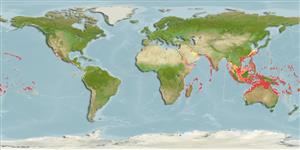>
Mulliformes (Goatfishes) >
Mullidae (Goatfishes)
Etymology: Parupeneus: Latin, parum, parvum = small + Peneus, the name of a river.
More on author: Bennett.
Environment: milieu / climate zone / depth range / distribution range
Ökologie
seewasser riff-verbunden; tiefenbereich 1 - 120 m (Ref. 89972). Tropical; 30°N - 30°S
Indo-Pacific: East Africa to Hawaii and the Line, Marquesas and Tuamoto islands, north to the Ryukyu Islands, south to Lord Howe and Rapa islands.
Size / Gewicht / Alter
Maturity: Lm ? range ? - ? cm
Max length : 33.0 cm TL Männchen/unbestimmt; (Ref. 9710); common length : 20.0 cm TL Männchen/unbestimmt; (Ref. 30573); max. veröff. Gewicht: 906.00 g (Ref. 4887)
Rückenflossenstacheln (insgesamt): 8; Rückenflossenweichstrahlen (insgesamt): 9; Afterflossenstacheln 1; Afterflossenweichstrahlen: 7; Wirbelzahl: 24. Diagnosis: Pectoral rays 16 (rarely 15 or 17). Gill rakers 6-8 + 21-25 (total 28-32). Body depth 3.45-3.95 in SL; head length (HL) 2.85-3.1 in SL; dorsal profile of snout straight to slightly convex, the snout length 1.7-2.05 in HL; barbel length 1.3-1.55 in HL; longest dorsal spine 1.4-1.7 in HL; last dorsal soft ray of adults longer than penultimate ray, the latter contained 1.1-1.25 in length of the former; posterior margin of caudal-fin lobes straight to slightly convex; pectoral-fin length 1.3-1.5 in HL; pelvic-fin length 1.25-1.45 in HL. Body pinkish to yellowish gray, the scale edges narrowly dark, with a black spot about 3-4 scales in width on lateral line below posterior part of first dorsal fin, followed by a large pale pink to white spot; a blue spot often present on each scale above lateral line, always present posteriorly; pale blue spots, one per scale, ventrally on body, but often not visible; short blue lines radiating from eye except ventrally; barbels pale pink to white; basal third of second dorsal fin with a broad black or blackish band or a large black spot, sometimes extending onto adjacent back, the outer part of fin with narrow blue and yellow bands; anal fin with faint pale blue and yellow bands; remaining fins varying from yellowish gray to light red (Ref. 54393).
Primarily an insular species (Ref. 30573). Usually solitary, it occurs in seagrass beds (Ref. 41878) as well as over sand, rubble, or coral and rock bottoms of shallow lagoon and seaward reefs to a depth of at least 46 m (Ref. 30874). Benthopelagic (Ref. 58302). Feeds on benthic animals like crabs, polychaetes and other worms during the day (Ref. 30874), also shrimps, heart urchins, gastropods, pelecypods, foraminiferans, brittle stars, and fishes (Ref. 37816).
Life cycle and mating behavior
Geschlechtsreife | Fortpflanzung | Ablaichen | Eier | Fecundity | Larven
Randall, J.E., 2004. Revision of the goatfish genus Parupeneus (Perciformes: Mullidae), with descriptions of two new species. Indo-Pac. Fish. (36):64 p. (Ref. 54393)
IUCN Rote Liste Status (Ref. 130435)
Bedrohung für Menschen
Harmless
Nutzung durch Menschen
Fischereien: weniger kommerziell; Sportfisch: ja; Aquarium: Kommerziell
Mehr Information
NamenSynonymeMetabolismusRäuberÖkotoxikologieFortpflanzungGeschlechtsreifeAblaichenSpawning aggregationFecundityEierEientwicklung
ReferenzenAquakulturAquakultur ProfilZuchtlinienGenetikElectrophoresesVererbbarkeitKrankheitenVerarbeitungNutrientsMass conversion
Tools
Zusatzinformationen
Download XML
Internet Quellen
Estimates based on models
Preferred temperature (Ref.
123201): 24.3 - 29, mean 27.8 °C (based on 1504 cells).
Phylogenetic diversity index (Ref.
82804): PD
50 = 0.5000 [Uniqueness, from 0.5 = low to 2.0 = high].
Bayesian length-weight: a=0.01202 (0.00556 - 0.02601), b=3.10 (2.93 - 3.27), in cm total length, based on LWR estimates for this Genus-body shape (Ref.
93245).
Trophic level (Ref.
69278): 3.4 ±0.2 se; based on diet studies.
Widerstandsfähigkeit (Ref.
120179): mittel, Verdopplung der Population dauert 1,4 - 4,4 Jahre. (Preliminary K or Fecundity.).
Fishing Vulnerability (Ref.
59153): Low vulnerability (23 of 100).
Nutrients (Ref.
124155): Calcium = 34 [17, 75] mg/100g; Iron = 0.313 [0.159, 0.686] mg/100g; Protein = 17.8 [14.4, 20.8] %; Omega3 = 0.133 [0.075, 0.243] g/100g; Selenium = 60.6 [29.3, 142.2] μg/100g; VitaminA = 192 [39, 808] μg/100g; Zinc = 0.542 [0.328, 1.028] mg/100g (wet weight);
